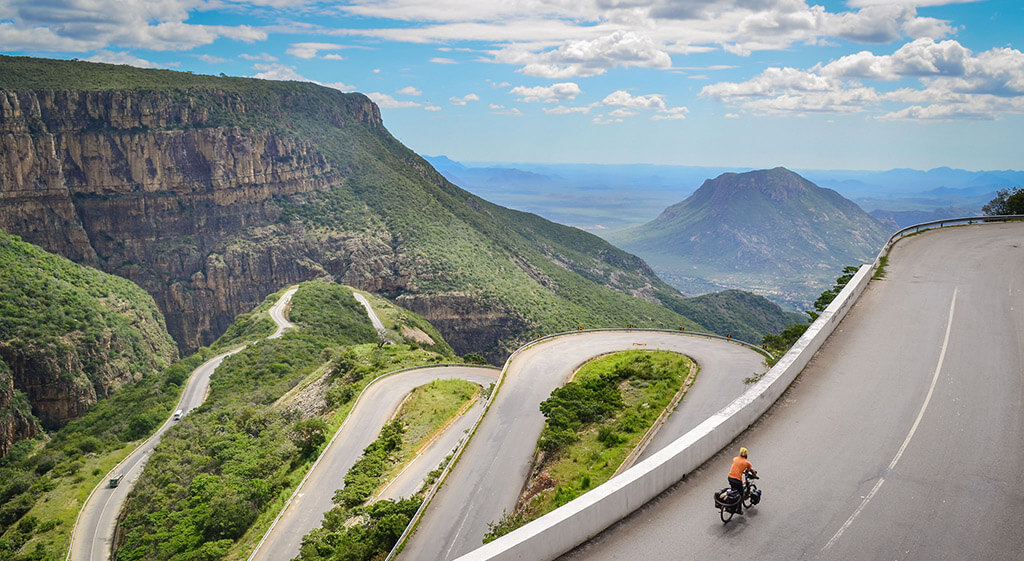Autumn Gear Guide
Find inspiration in our Gear Guide that will keep you out on your bike through wind or rain.
Download NowFrom finding the right bike to getting in shape, ten steps to bike touring adventures!

Photo by jbdodane
1. Get a bike that fits you, and that fits the style of riding you intend to do. Upright handlebars or drops? Skinny tires or fat? Loaded touring or supported? There are a lot of questions to answer before you decide. Of course, the bike you already own may work fine, at least for your first forays out onto the open road. If you’re totally unsure where to start, talk to someone at your local bike shop about the type of bike touring you’d like to do and in what area, and they can point you in the right direction for a bike.
2. Now that you have a bike, ride it. This sounds rather obvious, but some people try bicycle travel without adequate conditioning. Doing so is a good way to ensure you won’t want to try it again. Work up to day rides that are as long as your longest day on tour will be, adding to your distance in roughly five-mile (8 km) increments. You can find suggested training programs for different age and fitness categories online.
3. Add some weight to your bike. Even if you don’t plan to camp on tour, you’ll probably need to carry extra weight. You’ll also want to decide how to carry that weight. Regardless of the manner in which you haul it and how much it weighs, you’ll work harder riding a loaded bike than an unloaded one. Moreover, your bike will handle differently, and you’ll want to get used to these things in advance.
4. Read What to Take and How to Pack at the Adventure Cycling Association website. Lots of good advice there, including information on what clothes to wear and what to bring along.
5. Start out on a rail-trail, particularly if your first trip is a do-it-yourselfer. Converted railways are typically quite flat, traffic-free and very pleasant to ride.
6. Join a club. Most local bike clubs organize daylong and multi-day rides. Join up, make some new friends and learn the tricks of the bike travel trade from those who’ve been there.
7. If you plan to camp, begin with a short, overnight trip. Among other plusses, this will give you an opportunity to see how your non-bike gear — tent, camp stove, sleeping bag, etc. — is working. You’ll also find out whether or not you like sleeping on the ground.
8. Get inspired by doing some armchair travel. Prowl around the Crazy Guy on a Bike website or any number of bike touring blogs on the web for a while and you’ll find journals from traveling cyclists who have been to every corner of the globe. Reading about a multi-year, around-the-world adventure may make that weekend ride you’re dreaming of doing more plausible.
9. Read a good bike touring how-to book, like The Essential Touring Cyclist
10. Sign up for an intro to road touring course, which Adventure Cycling offers in a few states. These unique courses are designed to get you on the road with two days of classroom instruction followed by a four-day self-contained camping tour. A maximum of 20 riders are permitted in each class, guaranteeing a high instructor-to-student ratio. You can also do a quick online search for a comparable bike touring intro course in your region.
Michael McCoy is field editor for Adventure Cycling Association , the largest cycling membership group in North America. Adventure Cycling works to inspire people of all ages to travel by bicycle.
This article was originally published in 2010 and has been updated.
Find inspiration in our Gear Guide that will keep you out on your bike through wind or rain.
Download Now
Great article, I’d love to see hammocks added to this article, since swapping from a tent to a camping hammock it’s made bike touring so much more pleasant than sleeping on the ground. I use a grandtrunk hammock but there are many other brands. http://www.grandtrunk.com
Comments are closed.